Boy, can they!
Leave a freshly baked loaf of bread out to cool, with its heavenly smell wafting through the house, and you can bet the moment it goes unattended it will go missing.
But should dogs eat bread? Is bread good for dogs? Is anything about bread dangerous to dogs?
In an era where most of us see our pets as people with fur and paws, it is so important to get the facts about what “people” foods are okay for dogs to eat and which foods should stay off-limits.
Read this article to learn whether dogs can eat bread and everything you need to know on this important topic.

Should Dogs Eat Bread?
Can dogs eat bread? Yes, absolutely. Should dogs eat bread? The answer to this question is less clear.
As the American Kennel Club (AKC) points out, dogs can typically tolerate small quantities of bread without undue ill effect.
But “typically” does not mean always. Bread certainly isn’t an ideal diet for dogs, and here is why.

Is Bread Safe For Dogs?
For the past several years, the veterinary community has been continually wrestling with a great debate: are dogs omnivores (meat and plant diet) or carnivores (meat-only diet)?
As Tufts University Cummings Veterinary Medical Center explains, canine digestion has evolved in a specific way to more closely mirror that of humans.
This is not just true of the modern domestic dog’s digestive tract, by the way. It is also the case for dogs’ facial muscles – especially their eyebrows!
Living side by side with people for millennia has definitely had its impact on canine evolution. But this doesn’t mean dogs should scarf down bread the way many people do.
Cats Vs. Dogs: Obligate Carnivore Versus Scavenging Carnivore
Cats are obligate carnivores. This means their entire gastrointestinal system has evolved to digest meat – and only meat.
In contrast, dogs are scavenging carnivores, according to Dr. Mercola. This means they will ingest some plant material without undue ill effect, but it isn’t an ideal diet.
The distinction, according to Dr. Mercola, is in the difference between surviving and thriving. Dogs can even survive on a fully non-meat diet, but they are unlikely to thrive.
Furthermore, even if dogs are fed some (or all) plant-based food, it shouldn’t come from complex “people” foods like the processed grains and added ingredients found in most bread.

Is Bread Toxic To Dogs?
Just as with people, some dogs have sturdier digestive systems than others. Some dog breeds are genetically prone to have food sensitivities or food allergies. For these dogs, even a bite of bread may provoke an allergic reaction or stomach distress.
Dogs that have been diagnosed with autoimmune issues, thyroid problems or diabetes may also have adverse health reactions if not fed a strict veterinarian-prescribed diet.
For these dogs, bread may literally have a toxic impact on their bodies, even if bread itself isn’t typically viewed as toxic.
As well, not all bread is created equally. Some bread is much healthier than other bread.
Finding a purely organic, whole grain bread with unprocessed flour and no added salt or sugar is going to take some searching. Most bread has preservatives, processed flour, added salt and sugar, and sometimes other ingredients as well that are not good for dogs.
And if we expand the term “bread” to include raisin bread, garlic bread, chocolate croissants, cinnamon rolls, and similar delicacies, it quickly becomes clear how bread can be outright toxic for all dogs. Raisins, garlic and onions, macadamia and other nuts, chocolate, and many spices are dangerous for dogs to consume and may require emergency veterinary treatment.
Worst of all, some sweet bread today are flavored with xylitol rather than sugar. Xylitol is a sugar replacement that is poisonous to dogs. If you even suspect your dog has ingested anything with xylitol in it, do not wait. Take your dog to the nearest veterinary urgent care immediately!

Can Dogs Eat Bread Dough?
Who doesn’t love the smell of bread dough rising?
If people love this smell, with our measly six million scent receptors, imagine how much your dog loves the smell, with their estimated 100 to 300 million scent receptors!
But what if your dog decides not to wait for the bread to rise, bake and cool and decides to slurp down that whole bowl of rising bread dough? Should you be concerned?
As Veterinary Partner explains, rising raw yeast-based bread dough creates ethanol. Ethanol is poisonous to dogs.
Whether your dog takes a bit of raw bread dough or ingests the entire raw loaf, the impact will be relative to the size of the dog. An otherwise healthy toy or miniature breed dog may have a fatal reaction. An otherwise healthy giant or large breed dog may experience less distress.
When your dog eats any amount of raw bread dough, the dough will continue to rise and expand when it reaches your dog’s stomach. This is because the inside of your dog’s stomach is optimal to continue the yeast reaction. The more the raw dough rises, the less room will remain in the stomach. Gas, bloating, abdominal distention, and severe pain can result.
The most important fact to remember here is to treat ingestion of raw bread dough as you would ingestion of any other poison and act now. It can take 15 to 30 minutes to see the impact and you should not wait. Call your veterinarian or, if it is after hours, head to the nearest veterinary urgent care center for evaluation and treatment.
Health symptoms of ethanol poisoning in dogs include:
- Nausea.
- Vomiting.
- Hypothermia (shivering, cold).
- Excessive thirst.
- Lack of coordination.
- Lethargy.
- Low blood pressure.
- Bad breath.
- Respiratory distress.
- Seizures.
- Coma.

Other Risks Of Dogs Eating Bread
There are some additional risks to consider if your dog eats bread.
When you suspect or know your dog has eaten bread, the first thing you need to do is try to figure out how much and what else might have been eaten along with the bread.
For example, did your dog eat just the bread or also the plastic wrapper or carton the bread came in? This can obstruct the G.I. system that can be dangerous or deadly.
It is also vital to identify if the bread had any peanut butter, butter, cream cheese, jam or other toppings or fillers.
Some of these ingredients are high in fat and can trigger pancreatitis, a dangerous inflammation of the pancreas that causes the body to start digesting itself.
Pancreatitis can be triggered by a high-fat diet. Some dog breeds are genetically predisposed to pancreatitis more than other dog breeds.
Other ingredients may contain xylitol, the artificial sweetener that is so deadly to dogs. Peanut butter is a particular culprit here so act quickly to identify what the ingredients were in any toppings so you can get your dog help if needed.
Finally, another potential risk when dogs eat bread is the size and type of bread itself. For example, take French bread, the crusty loaves with the very hard, thick outer bread shell.
A small or toy breed dog that tries to swallow a hunk of French bread could very well end up choking, especially as the bread gets stuck in the throat and absorbs more moisture and continues to expand.
But even a large dog may experience choking if they try to eat a large piece of bread or a whole loaf in a gulp.
In summary, dogs can eat bread but they probably shouldn’t eat bread. This is especially the case for dogs with special genetic or other health issues, such as pancreatitis, thyroid imbalance, diabetes or food allergies.
When you think your dog has eaten bread, but you don’t see any warning signs and you don’t think the bread contained xylitol or other dangerous ingredients, continue to observe your dog closely for any signs of discomfort. Your dog’s veterinarian may have more specific guidance to offer and it is always wise to reach out for help.
The best course of action is not to feed your dog bread, even as a treat. There are other foods that are safer and healthier that you can offer.
Learn More: What Can Dogs Eat? A Comprehensive List Of Dog-safe Foods

